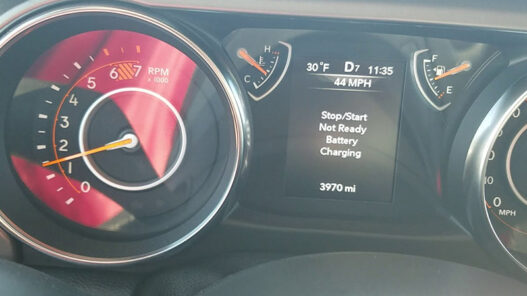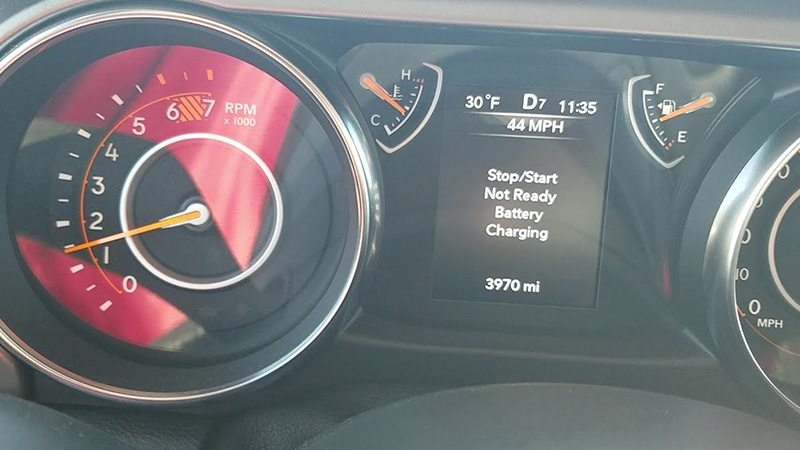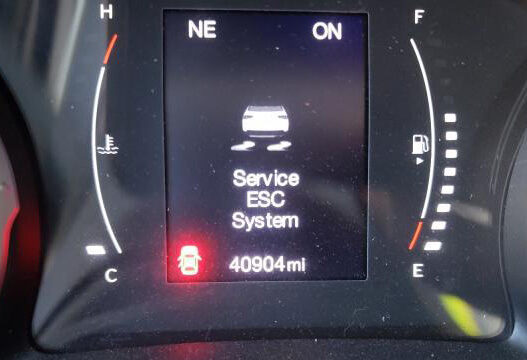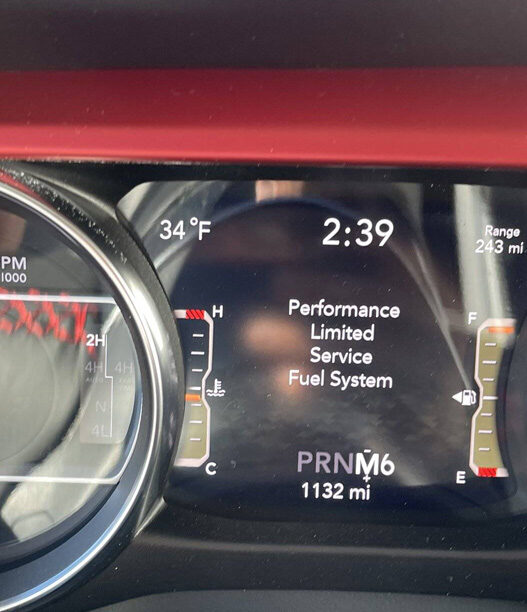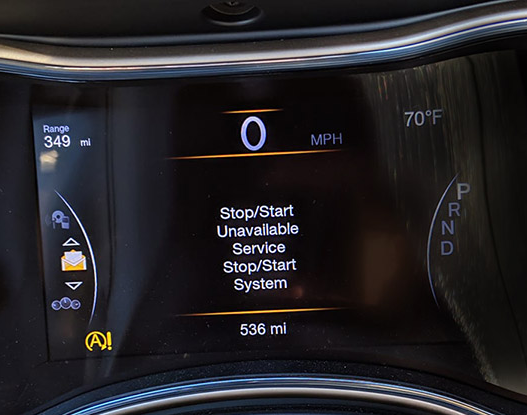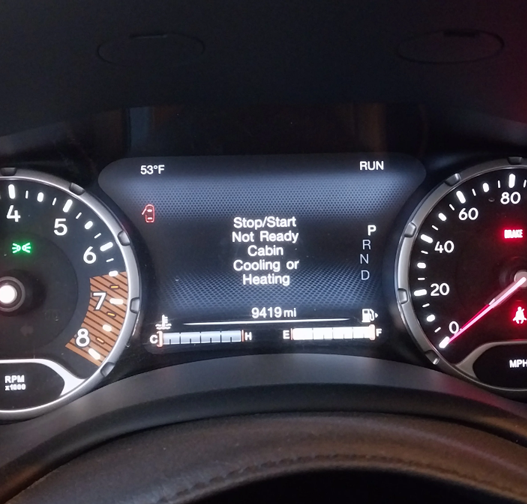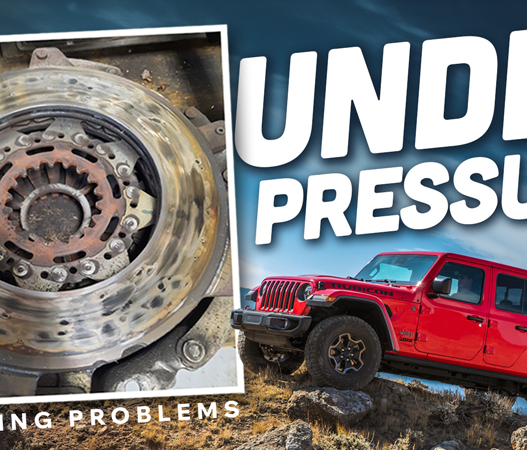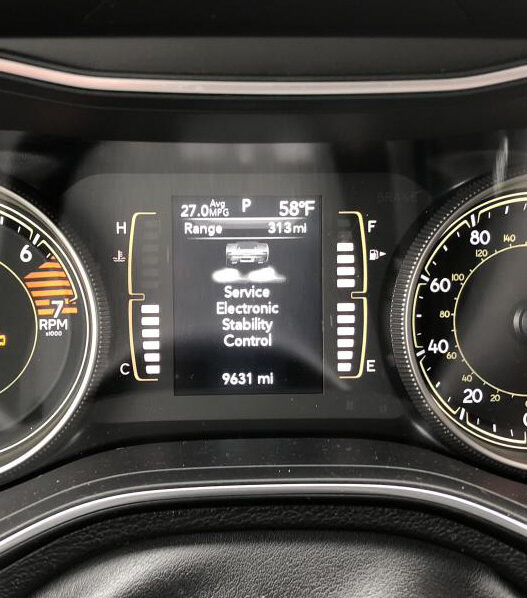You get behind the wheel of your Jeep, turn the key, and the engine attempts to start but fails to ignite. The dashboard flashes a warning message: ” Stop Start Not Ready Battery Charging.” You’re already running late, and now your Jeep won’t start. What’s the deal?
This frustrating alert is linked to your Jeep’s fuel-saving stop/start system, designed to automatically shut off the engine when you brake and restart it seamlessly when you accelerate.
However, sensitive electronics can sometimes encounter glitches, leaving you in a frustrating situation.
Before you panic, let’s delve into how these stop start systems function, identify common issues such as battery failures and software malfunctions, and provide guidance on resetting your Jeep’s system to get you moving again.
By conducting some simple troubleshooting, you can decode that perplexing Jeep Start Stop Not Ready Battery Charging warning and address the problem swiftly. Let’s dive into the specifics of this issue and the steps to resolve it efficiently!
How Do Stop/Start Systems Work? How Do They Work?
The purpose of stop-start technology is to enhance fuel efficiency and reduce emissions. By preventing fuel burn and pollution output during idle periods, such as at red lights and in traffic congestion, this technology helps save gas and decrease environmental impact.
These intelligent systems automatically halt the engine when the vehicle comes to a stop at speeds below 5 mph. A combined starter/generator swiftly restarts the engine when the brake is released. This start-stop process occurs seamlessly without requiring driver intervention during regular driving.
When implemented effectively, auto stop-start can lead to a significant improvement of 7-30% in city fuel economy by minimizing fuel consumption during standstills. Additionally, it reduces noise and exhaust emissions when the vehicle is stationary in traffic. Over time, the cumulative fuel and emission savings can be substantial.
Stop / Start Not Ready Battery Charging Operation Details
Advanced electronics govern the activation of stop-start functionality, fine-tuning its performance based on current conditions. Sensors continuously monitor factors such as vehicle speed, battery charge, engine and cabin temperature, among others.
If all parameters are within the specified range, the engine will shut off when braking under 5 mph for more than 5 seconds. It promptly restarts when acceleration is detected by the sensors. Additionally, the starter will automatically reignite the engine if there are changes in conditions or if the battery level drops below a certain threshold.
However, there are scenarios where the system will not engage, such as during extreme hot or cold weather, insufficient battery charge, or when the cabin temperature is not at the desired level. Users also have the option to manually deactivate the system if preferred. It is important to note that there may be a learning curve in adjusting to the on-off engine cycling process.
Maintaining Battery and Charge
In stop-start vehicles, a robust battery is utilized to manage more than 300,000 start cycles. This battery powers an integrated starter/generator responsible for spinning the engine during restarts.
Additionally, the generator functions to charge the battery during braking intervals by harnessing braking energy.
Despite these mechanisms, the frequent starting and stopping process can gradually deplete the battery’s lifespan. Absorbent glass mat batteries, which are utilized in these vehicles, tend to be more expensive. It is crucial to ensure the battery remains in optimal condition to uphold dependable auto stop-start functionality and prevent potential issues.
Stop Start Not Ready Battery Charging: 7 Causes and Fixes
This bothersome warning indicator is indicating that there is an issue hindering the proper operation of the stop/start system. Identifying the underlying problem requires investigating key components to restore functionality to your Jeep.
In this guide, we will investigate the six prevalent issues that commonly affect the system.
1. Battery Issues
A battery that is not sufficiently charged or experiencing decline is the primary cause of issues with stop/start functionality. These systems require a significant amount of battery power to repeatedly restart the engine while driving.
Signs of a deteriorating battery include warning indicators and the failure of the auto stop feature to engage.

Troubleshooting
Utilize a multimeter to examine the battery’s charge status and the voltage of the charging system. If the voltage is below 12.4 volts, charge the battery. Check for corrosion and loose connections in terminals and cables that may hinder the charging process.
The battery could also be deteriorated and may need to be substituted.
Solutions
Revitalize or swap out drained batteries to regain operational efficiency of the system. Ensure to maintain cleanliness of electrical connections and inspect the alternator belt tension.
It may be beneficial to switch to the absorbent glass mat battery with the highest cold cranking amps (CCA) suitable for your Jeep model, as this can enhance durability especially in situations with frequent starting and stopping.
2. Alternator Problems
The increased energy requirements of stop/start operations also place additional stress on the charging system. A malfunctioning alternator may struggle to maintain the battery’s charge during frequent stops, triggering warning indicators if the voltage drops too low for a successful restart.
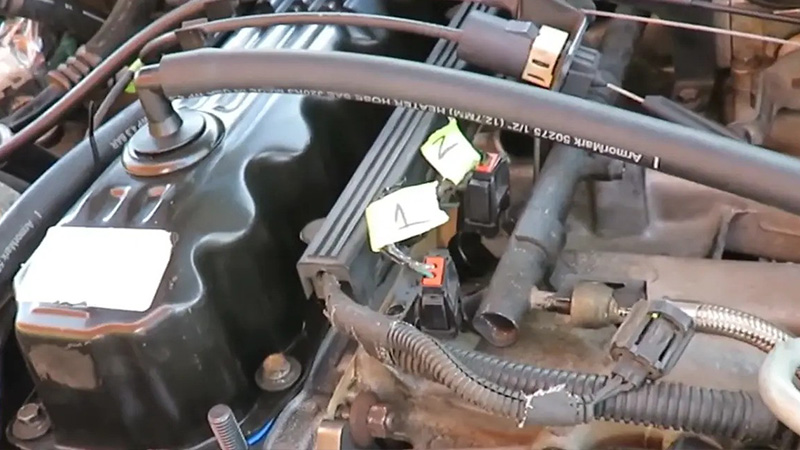
Troubleshooting
Use a multimeter to detect inconsistent charging voltage, typically below 13.7 volts. Signs of alternator issues include grinding noises from bearings or the smell of burning belts. Testing the alternator diodes can help identify potential internal wiring faults or faulty rectifiers
Solutions
Addressing charging issues promptly enables straightforward repairs such as replacing bearings or brushes on the alternator. In cases where the alternator is significantly worn out, it may require rebuilding or complete replacement, in addition to inspecting associated belt connections.
This upkeep ensures that the battery’s recharging capacity remains sufficient for handling stop/start operational cycles.
3. Electrical System Faults
Similar to any intricate digital-mechanical system, the stop/start feature depends on electrical signals received from sensors that track operations.
Issues such as damaged wiring harnesses, poor grounding, or malfunctioning components can replicate charging problems and prevent the stop/start function from working properly.
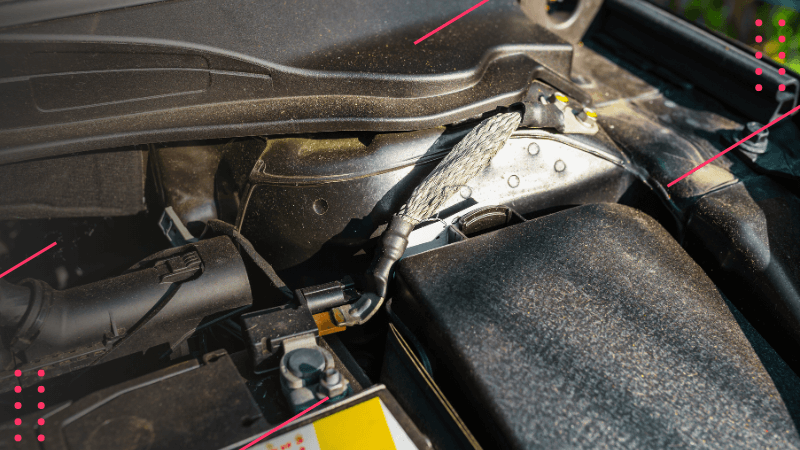
Troubleshooting
Examine the wiring harness connectors and grounds connected to stop/start components for signs of corrosion, harm, or looseness. Also, inspect the fuses supplying power to the system.
Additionally, conduct a scan for fault codes indicating issues with sensors such as the brake pedal position, accelerator position, or engine speed, which may be sending inaccurate data to the computer.
Solutions
Inspect and address any corroded connectors, frayed wiring, or loose grounds that may disrupt signal transfer.
Replace any sensors that are suspected to be faulty, such as the crankshaft position sensor that provides data to the control module.
Clear any error codes, calibrate new components, and test for proper stop/start functionality. If problems persist, additional electrical diagnostics may be required.
4. Software Glitches
The current stop/start systems utilize sophisticated programming with adaptive learning to control activation parameters.
However, software bugs may occasionally disable functions and prompt the system to enter a reboot mode, as indicated by warning lights.

Troubleshooting
Access the stop/start control module to check for any pending fault codes related to invalid data inputs or program operation errors. Pay attention to warning lights illuminating, even with normal electrical signals and battery voltage, as this may indicate underlying computer control glitches.
Solutions
Updating the stop/start software to current specifications can help resolve intermittent activation issues. Performing complete resets to clear all adaptive memory may also help refresh the system.
In cases where computer issues persist, the dealer may need to utilize programming tools to identify and revise faulty code. This process can restore systems to proper functionality and prevent unexpected shutdowns.
5. Temperature Variations
Extreme underhood temperatures can disrupt stop/start operations, whether in icy winter cold or scorching summer heat. Components may not perform optimally outside of their ideal temperature ranges, leading the system to play it safe by refraining from activation and displaying warnings such as “start/stop not ready battery charging.”

Troubleshooting
Monitor ambient temperatures during suspected climate-related issues. Temperature sensors may falsely indicate extremes if damaged. Scan for pending fault codes specifically related to out-of-range values from temperature sensors that could trigger shutdowns during weather fluctuations.
Solutions
Electronics like ECUs or sensors rarely fail solely due to temperatures; they are designed to endure winter or summer extremes. Extreme cold may affect battery output, while extreme heat can strain the alternator. Prioritize checking other related systems before assuming temperature sensors are faulty.
Identifying and addressing the root electrical or mechanical issue will help restore normal function. The stop/start programming adjusts for ambient temperatures during full system operation.
6. Auxiliary Battery Concerns
Some Jeep Cherokee models feature a secondary auxiliary battery specifically designed to handle the high electrical loads of the stop/start system. Issues with this auxiliary battery can lead to problems resembling charging system issues or result in shutdowns of the stop/start feature.
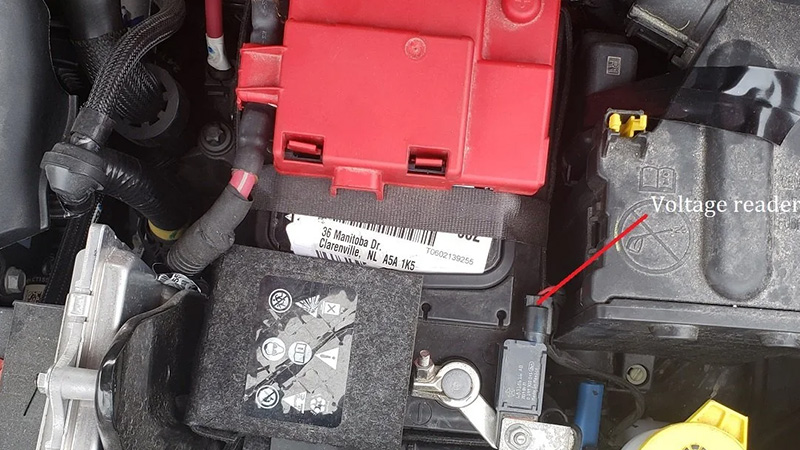
Troubleshooting
Inspect the mounting, terminals, and voltage of the auxiliary battery separately from the main starting battery. The auxiliary battery may require testing and charging attention to ensure proper cranking support for the starter/generator during engine restarts.
Solutions
Recharge or replace a failing auxiliary battery to allow the stop/start’s integrated starter/generator to operate at peak performance. Ensure the isolation diode that splits charge duties between the main and auxiliary batteries is not damaged.
Maintaining proper voltage across both batteries is crucial for seamless stop/start cycling. Once the battery bank is restored on both main and auxiliary sides, the stop/start system should activate reliably during normal commutes.
When diagnosing a troublesome system, do not overlook the second hidden battery. Methodically checking each possible cause helps track down issues effectively.
7. Parasitic Battery Drain
Troubleshooting
A parasitic battery drain occurs when an electrical component or system in the vehicle continues to draw power from the battery even when the vehicle is turned off. This constant drain can deplete the battery, causing issues with the Stop/Start system as the battery does not maintain sufficient charge.
Solutions
To fix a parasitic battery drain, use a multimeter to measure the current draw from the battery, identifying any excessive draw. Isolate the problem by pulling fuses one at a time to pinpoint the faulty circuit. Inspect the associated wiring and components for damage or corrosion, and repair or replace any faulty parts.
If the issue involves complex electrical systems or is not easily identifiable, seek assistance from a professional mechanic or auto electrician. This ensures the battery maintains its charge and the Stop/Start system functions properly.
Diagnose and repair any components causing excessive battery drain, such as faulty wiring or malfunctioning electronics.
Best Tips to Prevent Future Stop/Start Issues
While the stop/start system is designed to save gas, it may result in increased strain on electrical components, leading to frustrating warning lights or potential starting issues.
Engaging in preventative maintenance can help minimize such issues in the future.
1. Regularly Check Battery & Alternator Health
The battery undergoes strain from repeated charging and discharging cycles, especially during engine restarts. Check the terminals for corrosion every month and test the charge levels at least twice a year to detect low voltage issues early on and prevent potential breakdowns.
Similarly, the alternator operates at full capacity to recharge the battery swiftly during auto-stops. Ensure it consistently maintains 12-14 volts while running to effectively replenish the battery.
Inspect the connections to ensure they are secure and listen for any bearing noises, which may indicate the need for replacement.
2. Update Software & Reset Adaptive Memory
Automotive engineers continuously enhance the intricate software that controls stop/start operations. Installing the latest software updates can resolve bugs and enhance efficiency by enabling systems to adapt to your driving habits.
Also, regular resetting of the stop/start system eliminates any inaccurate adaptive memory that may be causing activation problems, providing components with a clean slate and recalibrating their performance.
3. Consider Using an Auxiliary Battery
Incorporating a supplemental absorbent glass mat battery specifically for the high electrical demands of the stop/start function alleviates stress on the primary starting battery. Isolating reserve capacity helps prevent voltage drops. Additionally, installing heat shields and battery blankets provides enhanced protection for batteries against extreme underhood temperatures in both winter and summer.
Maintaining components at optimal operating conditions guarantees consistent performance throughout the year.
What Does Stop Start Not Ready Battery Charging Mean?
How Long Does a Stop Start Battery Take to Charge?
What Does It Mean When My Jeep Says Start Stop Not Ready?
Conclusion
In summary, Jeep’s fuel-saving Stop/Start technology can strain electrical systems due to frequent auto engine restarts, leading to glitches like “Not Ready” errors when components are unable to meet the demand.
The warning for “Stop Start not ready battery charging” suggests a lack of sufficient voltage to activate the system, possibly caused by battery, sensor, or hardware issues.
Software glitches or errors could also impact the vehicle’s performance. By identifying these potential issues, you can troubleshoot effectively and restore the functionality of your Jeep’s stop/start system, saving money on gas and avoiding the inconvenience of persistent warning lights







